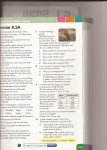Here is the question it is no. 10 below:

The first issue that bugged me was the fact that it gives the weight of the cylinder and not the mass, so if you want to work out the volume (which I think you need to do to find the height using Pi r^2 h, you need to use Density = M/V. I can't believe the question really wants you to convert weight to mass which means using a gravitational field strength of 9.8N/kg!!!
So I started by trying to find the volume: Density = 19.3 g/cm^3 = 1200/V . 1200/19.3 = 62.2 cm^3(1 dp)
Now the first bit asks to find the the upper bound on the height of the cylinder. So the upper bound of the measurements that have been rounded to 1dp will be:
Weight= 1250 g. Density= 19.35 g/cm^3. So volume will be : 1250/19.35 = 64.6(1dp) so using the volume formula we get:
Pi x 2.5(radius upper bound) x h = 64.6 = 64.6/(Pi x 2.5) =8.28. BUT the answer given is 5.4 - I've obviously made a blunder I cannot see!

The first issue that bugged me was the fact that it gives the weight of the cylinder and not the mass, so if you want to work out the volume (which I think you need to do to find the height using Pi r^2 h, you need to use Density = M/V. I can't believe the question really wants you to convert weight to mass which means using a gravitational field strength of 9.8N/kg!!!
So I started by trying to find the volume: Density = 19.3 g/cm^3 = 1200/V . 1200/19.3 = 62.2 cm^3(1 dp)
Now the first bit asks to find the the upper bound on the height of the cylinder. So the upper bound of the measurements that have been rounded to 1dp will be:
Weight= 1250 g. Density= 19.35 g/cm^3. So volume will be : 1250/19.35 = 64.6(1dp) so using the volume formula we get:
Pi x 2.5(radius upper bound) x h = 64.6 = 64.6/(Pi x 2.5) =8.28. BUT the answer given is 5.4 - I've obviously made a blunder I cannot see!
